Abstract
The molecular weight and amino acid composition of triose phosphate isomerase have been determined. The molecular weight (43000) is lower and the molecular activity (500000) higher than those of most other glycolytic enzymes. Reaction with iodoacetate (studied with radioactive reagent) takes place in two phases: in the first phase, at pH6·3, cysteine and methionine groups react and enzymic activity is unimpaired; in the second phase, histidine reacts and enzymic activity is lost. Photo-oxidation leads to inactivation, with loss of cysteine, of histidine and of tryptophan, but little loss of tyrosine. The mechanism postulated for the action of the enzyme demands the intervention of a group functioning as a base, and the results obtained are consistent with histidine's being the basic group in the active centre.
Full text
PDF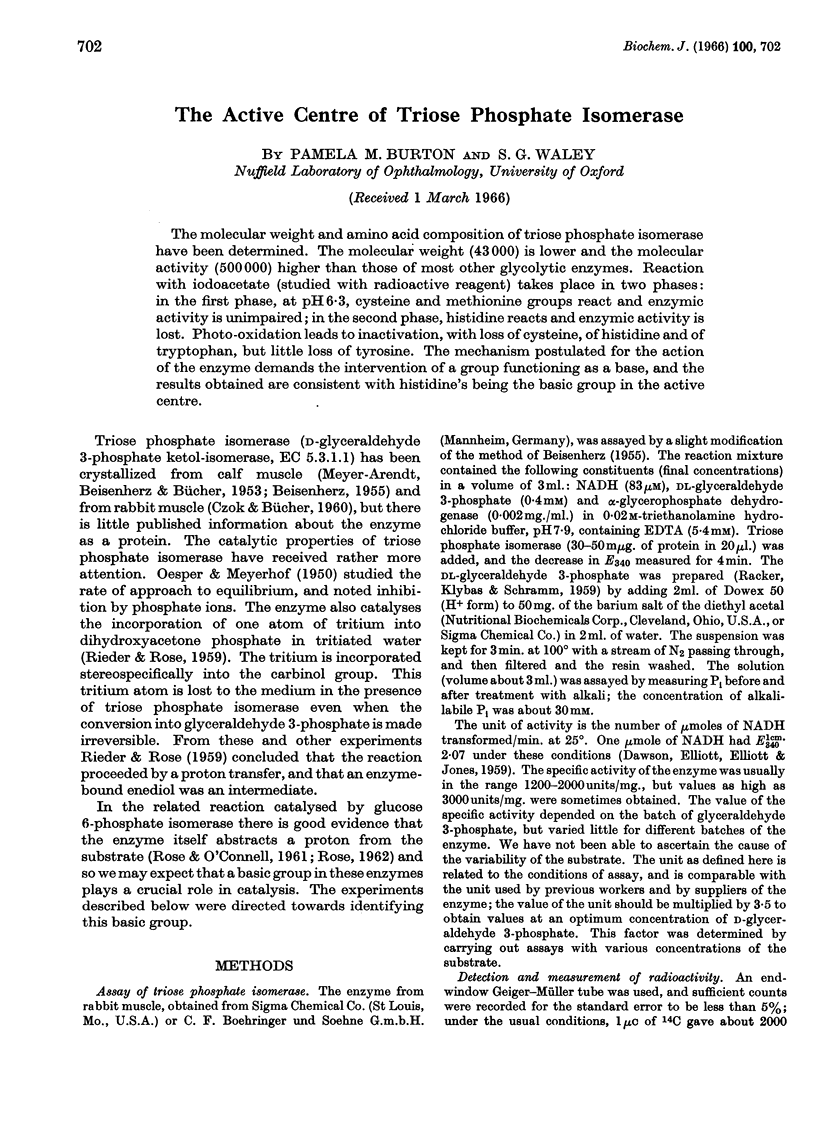

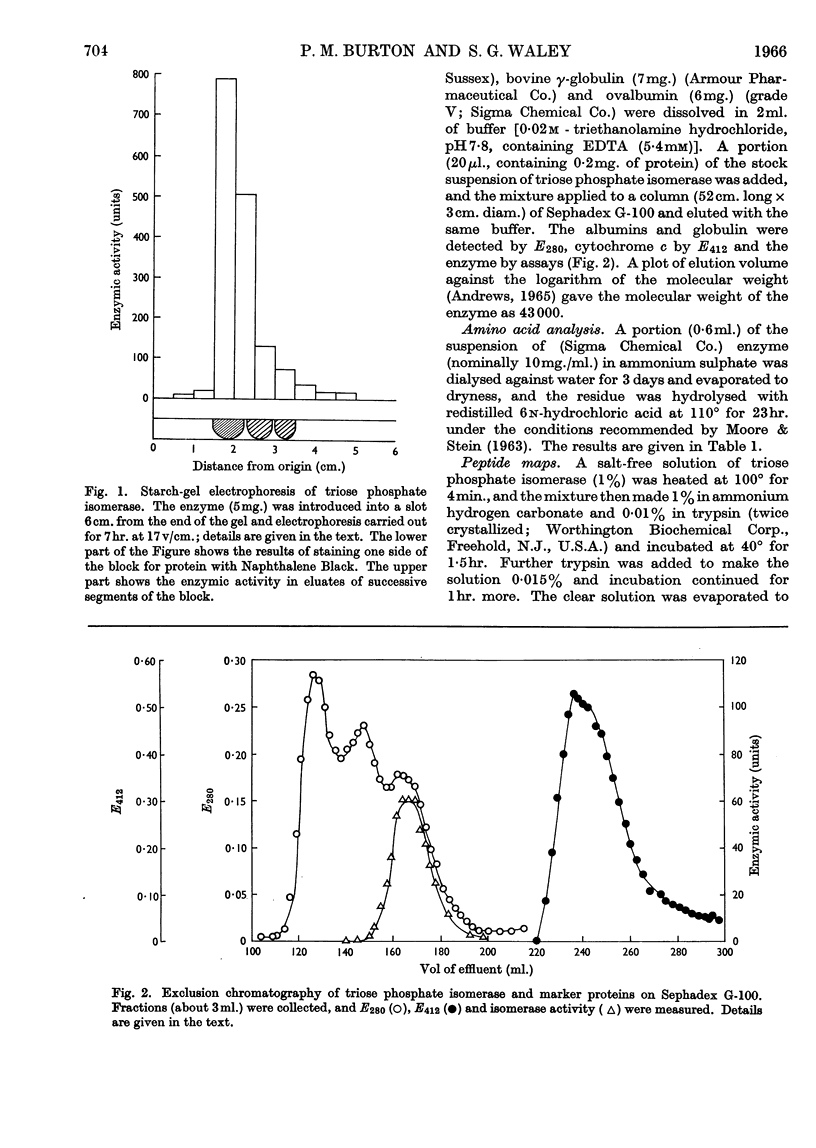
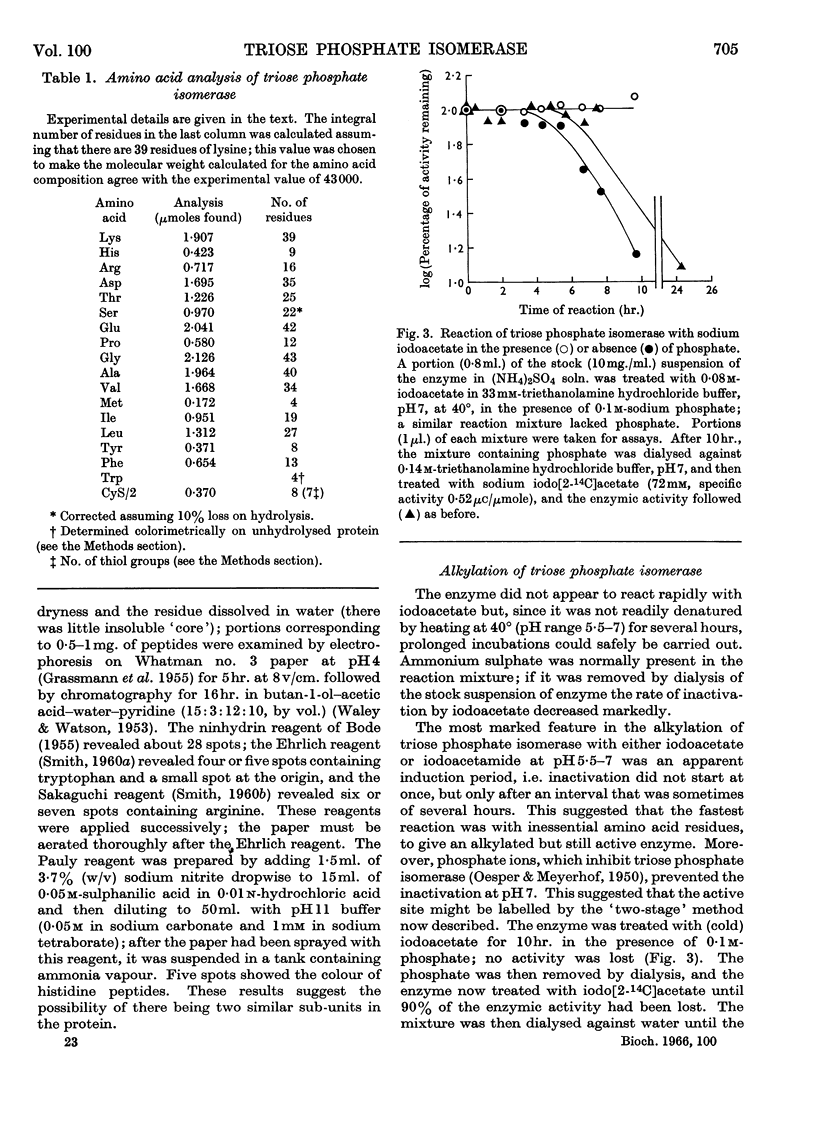
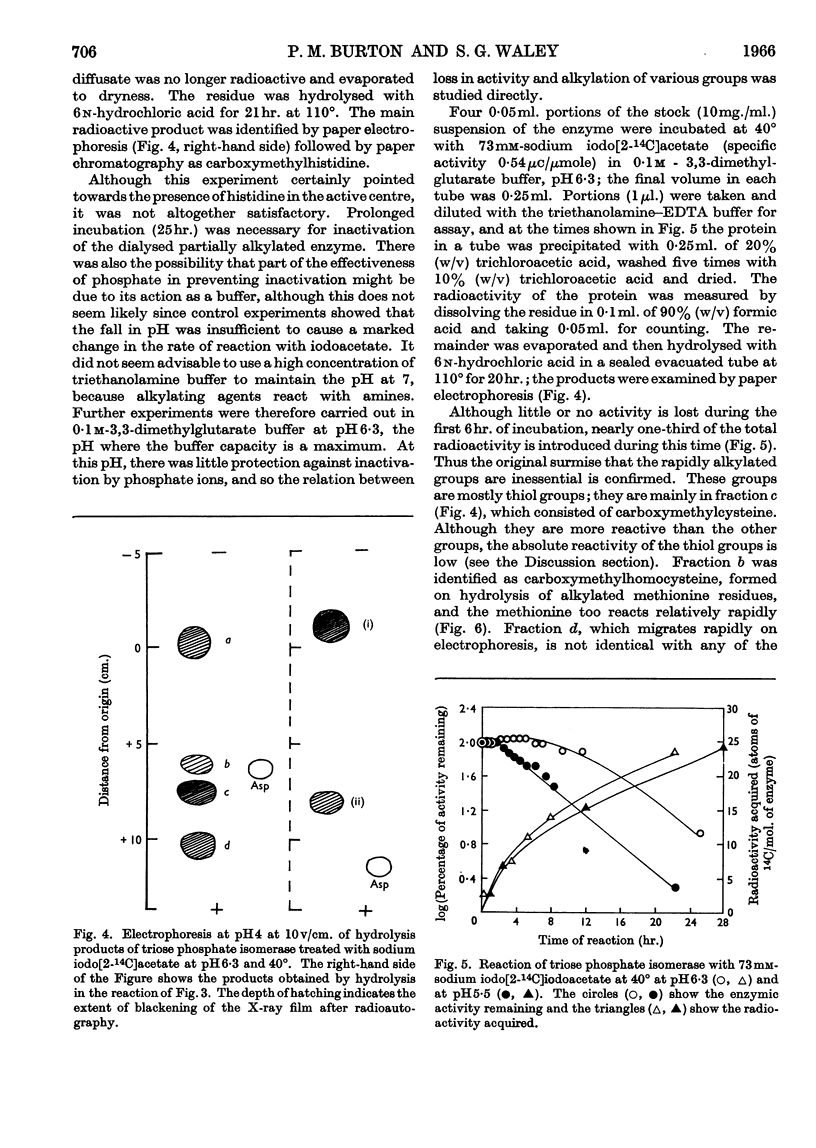
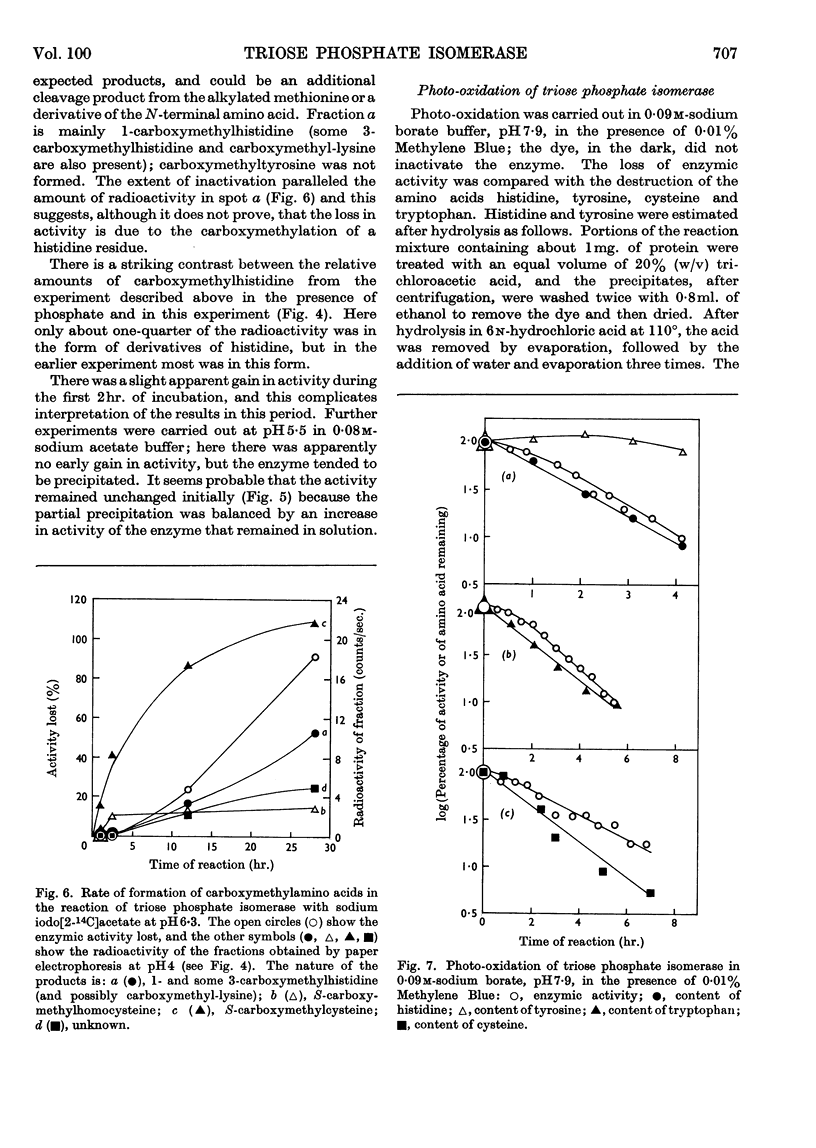
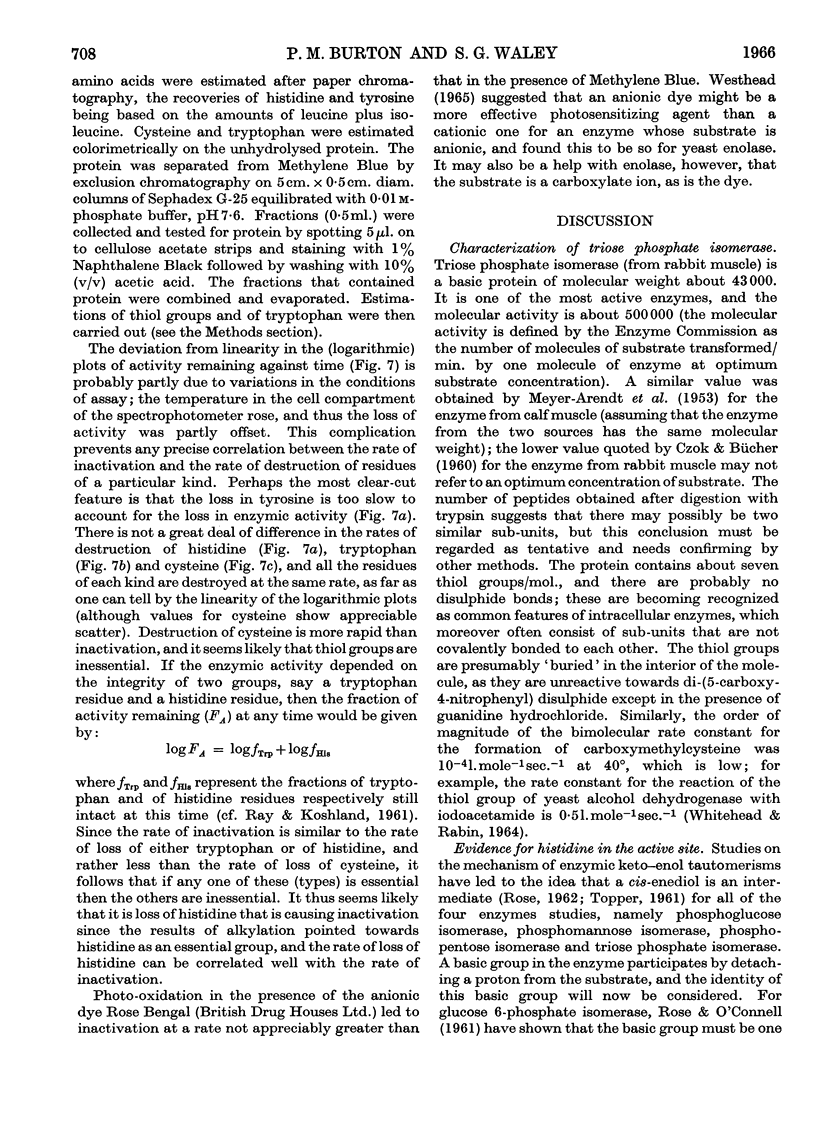
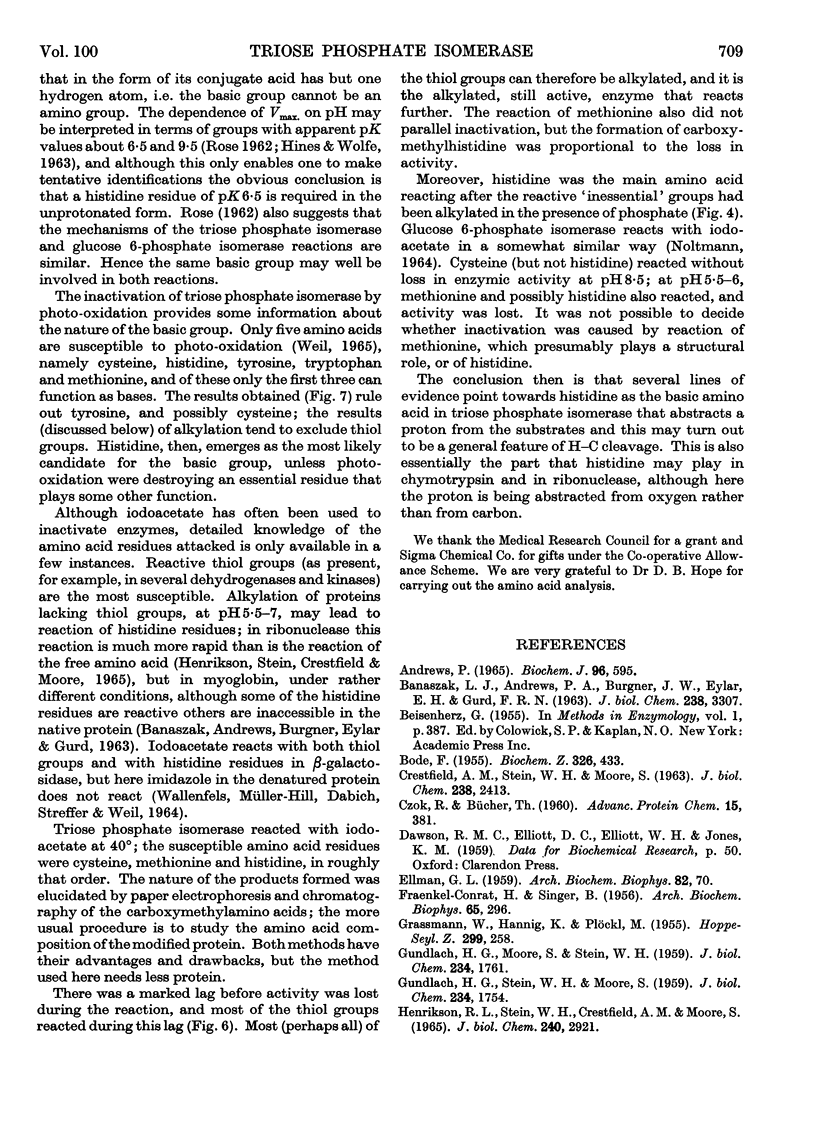
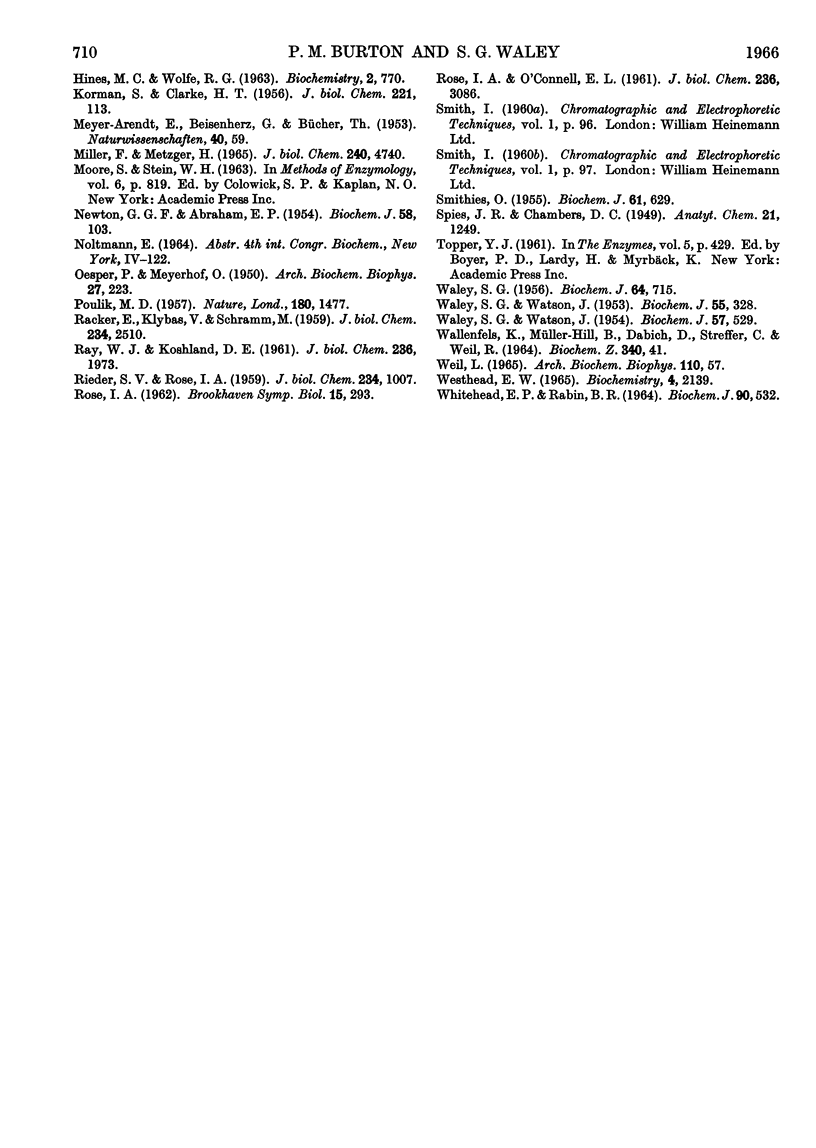
Selected References
These references are in PubMed. This may not be the complete list of references from this article.
- Andrews P. The gel-filtration behaviour of proteins related to their molecular weights over a wide range. Biochem J. 1965 Sep;96(3):595–606. doi: 10.1042/bj0960595. [DOI] [PMC free article] [PubMed] [Google Scholar]
- BANASZAK L. J., ANDREWS P. A., BURGNER J. W., EYLAR E. H., GURD F. R. CARBOXYMETHYLATION OF SPERM WHALE METMYOGLOBIN. J Biol Chem. 1963 Oct;238:3307–3314. [PubMed] [Google Scholar]
- BODE F. Eine Vereinfachung und Verbesserung der Methode zur quantitativen Bestimmung von Aminosäuren und Peptiden mittels des Ninhydrin-Kupferkomplexes. Biochem Z. 1955;326(6):433–435. [PubMed] [Google Scholar]
- CRESTFIELD A. M., STEIN W. H., MOORE S. Alkylation and identification of the histidine residues at the active site of ribonuclease. J Biol Chem. 1963 Jul;238:2413–2419. [PubMed] [Google Scholar]
- ELLMAN G. L. Tissue sulfhydryl groups. Arch Biochem Biophys. 1959 May;82(1):70–77. doi: 10.1016/0003-9861(59)90090-6. [DOI] [PubMed] [Google Scholar]
- FRAENKEL-CONRAT H., SINGER B. A new technique for the analysis of histidine, tyrosine, methionine and arginine in protein hydrolysates. Arch Biochem Biophys. 1956 Nov;65(1):296–301. doi: 10.1016/0003-9861(56)90195-3. [DOI] [PubMed] [Google Scholar]
- GRASSMANN W., HANNIG K., PLOCKL M. Eine Methode zur quantitativen Bestimmung der Aminosäurezusammensetzung von Eiweisshydrolysaten durch Kombination von Elektrophorese und Chromatographie. Hoppe Seylers Z Physiol Chem. 1955;299(5-6):258–276. [PubMed] [Google Scholar]
- GUNDLACH H. G., MOORE S., STEIN W. H. The reaction of iodoacetate with methionine. J Biol Chem. 1959 Jul;234(7):1761–1764. [PubMed] [Google Scholar]
- GUNDLACH H. G., STEIN W. H., MOORE S. The nature of the amino acid residues involved in the inactivation of ribonuclease by iodoacetate. J Biol Chem. 1959 Jul;234(7):1754–1760. [PubMed] [Google Scholar]
- HEINRIKSON R. L., STEIN W. H., CRESTFIELD A. M., MOORE S. THE REACTIVITIES OF THE HISTIDINE RESIDUES AT THE ACTIVE SITE OF RIBONUCLEASE TOWARD HALO ACIDS OF DIFFERENT STRUCTURES. J Biol Chem. 1965 Jul;240:2921–2934. [PubMed] [Google Scholar]
- HINES M. C., WOLFE R. G. PHOSPHOGLUCOSE ISOMERASE. II. INFLUENCE OF PH ON KINETIC PARAMETERS. Biochemistry. 1963 Jul-Aug;2:770–775. doi: 10.1021/bi00904a025. [DOI] [PubMed] [Google Scholar]
- KORMAN S., CLARKE H. T. Carboxymethylamino acids and peptides. J Biol Chem. 1956 Jul;221(1):113–131. [PubMed] [Google Scholar]
- Miller F., Metzger H. Characterization of a human macroglobulin. II. Distribution of the disulfide bonds. J Biol Chem. 1965 Dec;240(12):4740–4745. [PubMed] [Google Scholar]
- NEWTON G. G., ABRAHAM E. P. Degradation, structure and some derivatives of cephalosporin N. Biochem J. 1954 Sep;58(1):103–111. doi: 10.1042/bj0580103. [DOI] [PMC free article] [PubMed] [Google Scholar]
- OESPER P., MEYERHOF O. The determination of triose phosphate isomerase. Arch Biochem. 1950 Jun;27(1):223–233. [PubMed] [Google Scholar]
- POULIK M. D. Starch gel electrophoresis in a discontinous system of buffers. Nature. 1957 Dec 28;180(4600):1477–1479. doi: 10.1038/1801477a0. [DOI] [PubMed] [Google Scholar]
- RACKER E., KLYBAS V., SCHRAMM M. Tetrose diphosphate, a specific inhibitor of glyceraldehyde 3-phosphate dehydrogenase. J Biol Chem. 1959 Oct;234:2510–2516. [PubMed] [Google Scholar]
- RAY W. J., Jr, KOSHLAND D. E., Jr A method for characterizing the type and numbers of groups involved in enzyme action. J Biol Chem. 1961 Jul;236:1973–1979. [PubMed] [Google Scholar]
- RIEDER S. V., ROSE I. A. The mechanism of the triosephosphate isomerase reaction. J Biol Chem. 1959 May;234(5):1007–1010. [PubMed] [Google Scholar]
- ROSE I. A. Mechanism of C-H bond cleavage in aldolase and isomerase reactions. Brookhaven Symp Biol. 1962 Dec;15:293–309. [PubMed] [Google Scholar]
- ROSE I. A., O'CONNELL E. L. Intramolecular hydrogen transfer in the phosphoglucose isomerase reaction. J Biol Chem. 1961 Dec;236:3086–3092. [PubMed] [Google Scholar]
- SMITHIES O. Zone electrophoresis in starch gels: group variations in the serum proteins of normal human adults. Biochem J. 1955 Dec;61(4):629–641. doi: 10.1042/bj0610629. [DOI] [PMC free article] [PubMed] [Google Scholar]
- WALEY S. G. Acidic peptides of the lens. Biochem J. 1956 Dec;64(4):715–726. doi: 10.1042/bj0640715. [DOI] [PMC free article] [PubMed] [Google Scholar]
- WALEY S. G., WATSON J. The action of trypsin on polylysine. Biochem J. 1953 Sep;55(2):328–337. doi: 10.1042/bj0550328. [DOI] [PMC free article] [PubMed] [Google Scholar]
- WALEY S. G., WATSON J. Trypsin-catalysed transpeptidations. Biochem J. 1954 Aug;57(4):529–538. doi: 10.1042/bj0570529. [DOI] [PMC free article] [PubMed] [Google Scholar]
- Whitehead E. P., Rabin B. R. The thiol groups of yeast alcohol dehydrogenase. Biochem J. 1964 Mar;90(3):532–539. doi: 10.1042/bj0900532. [DOI] [PMC free article] [PubMed] [Google Scholar]


